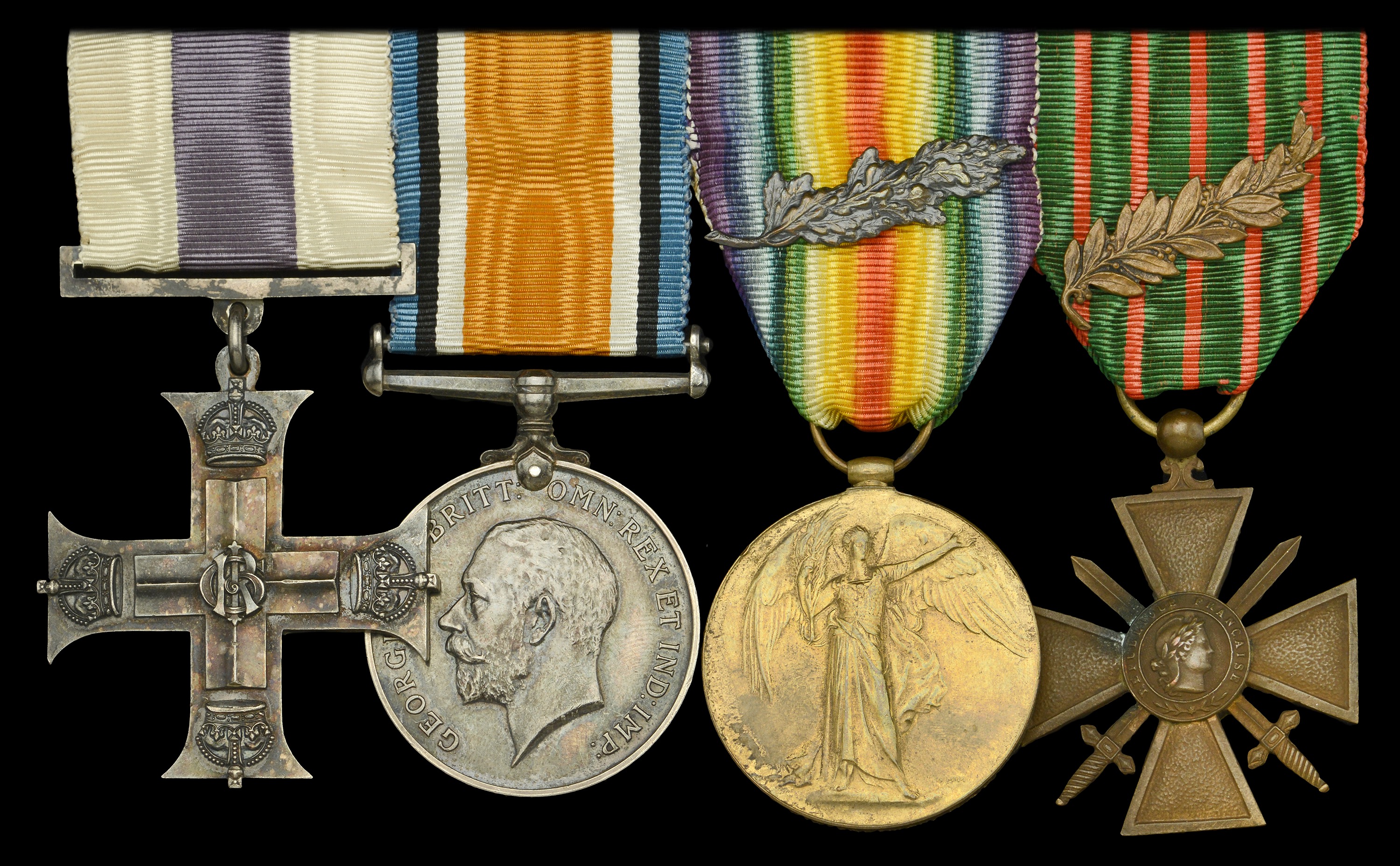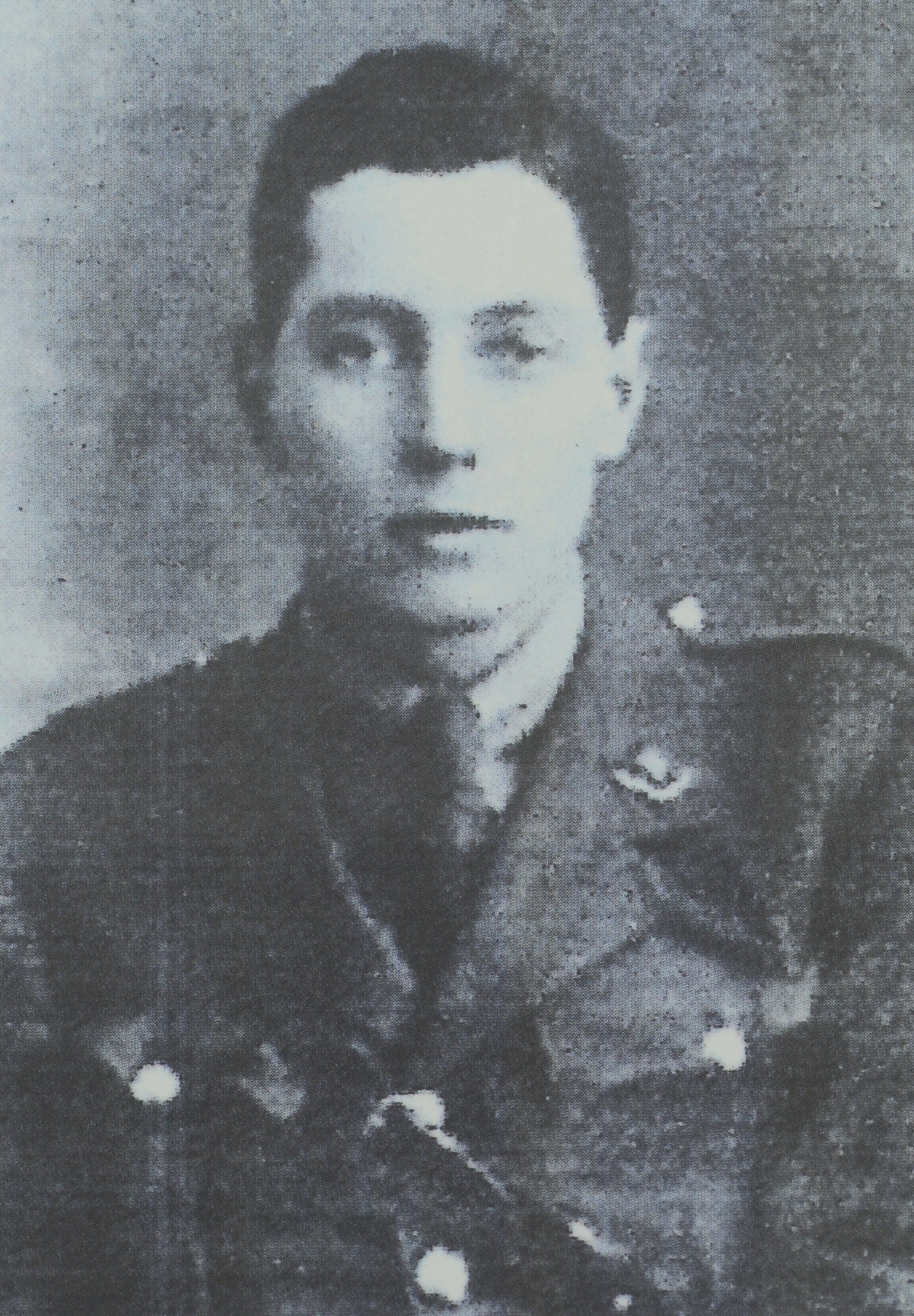75
A fine Great War 'Egyptian theatre' M.C. group of four awarded to Major R. H. Freeman,...
Bids do not include VAT, buyer’s premium or delivery.
By confirming your bid, you agree that you have read and accepted the-saleroom.com and the auctioneer's terms and conditions. Confirming your bid is a legally binding obligation to purchase and pay for the lot should your bid be successful.
Choose one of the quick bid options below:
Bids do not include VAT, buyer’s premium or delivery.
By confirming your bid, you agree that you have read and accepted the-saleroom.com and the auctioneer's terms and conditions. Confirming your bid is a legally binding obligation to purchase and pay for the lot should your bid be successful.
Freeman was also involved in a daring long distance bombing raid on a rail bridge on the Damascus-to-Medina Railway, 24 June 1917 - a round trip of 350 miles across the desert. He was appointed to the command of the Sopwith Camel equipped 73 Squadron, and was shot down and killed over France by the German Ace Leutnant Harry von Bulow-Bothkamp, 21 July 1918
Military Cross, G.V.R., reverse engraved ‘Capt. R. H. Freeman. R.A.F. Egypt 1915.’; British War and Victory Medals, with M.I.D. oak leaves (Major R. H. Freeman. R.A.F.); France, Third Republic, Croix de Guerre, bronze, reverse dated 1914-1916, with bronze palm on riband, mounted for wear, generally very fine or better (4) £2,800-£3,200
---
M.C. London Gazette 26 January 1917:
'For conspicuous gallantry in action. He attacked and drove off an enemy aeroplane which had forced one of our machines to land. Later he landed and rescued the pilot under very difficult conditions. He set a fine example of courage and initiative.'
M.I.D. London Gazette 6 July 1917.
France, Croix de Guerre London Gazette 21 May 1917.
Russell Herbert Freeman was born in January 1894, one of the eight children of William Robert Freeman and his wife Ann Farquharson Carr Dunn. Freeman's grandfather had been a partner in Mowlem, Freeman and Burt, a quarrying and construction firm which provided stone for many early Victorian building projects, such as the paving for Blackfriars Bridge. Freeman's father also worked in the firm. The family resided at 103 Westbourne Terrace, Paddington, London.
Freeman was educated at Winchester College, and studied medicine at Christ Church, Oxford. The outbreak of the Great War interrupted his studies, and Freeman was commissioned Second Lieutenant in the 3rd Battalion, Worcestershire Regiment in August 1914. He ’proceeded to France on 1 January 1915, and served in the trenches until the spring, when he was invalided home suffering with paratyphoid. Once recovered, he applied for secondment to the R.F.C., taking his Royal Aero Club Certificate (Number 2452) on 9 February 1916 [on a Maurice Farman bi-plane at Shoreham]. After completing his formal training, he was confirmed and gazetted Flying Officer on 16 May following. Sent out to Egypt and 14 Squadron [B.E.2c’s and Martinsyde Scouts], he arrived on 19 June 1916. Freeman was involved in a famous incident on 2 November 1916, when he landed his Martinsyde ‘Elephant’ in the desert alongside a crashed colleague’s machine and, taking off again, carried the downed Pilot, Captain F. F. R. Minchin, sitting astride the engine cowl, to safety.’ (The Military Cross to Flying Personnel of Great Britain and the Empire 1914-1919 bt H. Giblin and N. Franks refers)
It was for the aforementioned action that Freeman was awarded the Military Cross (an award also won during the Great War by his brother Wilfred Rhodes Freeman - who went on to become Air Chief Marshal Sir W. R. Freeman, G.C.B., D.S.O., M.C.).
On 24 June 1917, ‘Freeman and Lieutenant S. K. Muir, each in a Martinsyde Elephant, took part in an extremely, for those days, long-distance bombing raid with the intention of cutting the Damascus-to-Medina railway by bombing a bridge four miles south of Qal’at el Hasa. At one point during the flight the airmen had, ‘in simultaneous view, the Dead Sea, the River Jordan, the Mediterranean and the Red Sea.’ In the event, they failed to bring down the bridge, but succeeded in displacing some of the track. In part the raid was undertaken to demonstrate the wide range of British power to those tribesmen who had not yet committed themselves to either the Turkish or the Allied cause. The flight covered a distance of 350 miles and took more than 5 hours, but was successfully executed without loss. Freeman was Mentioned in Despatches for this feat.... His tour with ‘14’ completed, he returned to the UK and, after enjoying a short leave, was appointed an Instructor at the C.F.S., with the rank of A/Major and Squadron Commander. Sent out next to France to command the Sopwith Camel-equipped 73 Squadron, he was killed in action just three weeks later on 21 July 1918. His Camel, ‘D1918’, fell victim to Leutnant Harry von Bulow-Bothkamp of Jasta 36, the sixth and last of the German Ace’s victories [the latter went on to serve in the Second World War, and claim a further 12 victories]. Russell Freeman is buried in Raperie British Cemetery, Villemontoire, Aisne, France.’ (Ibid)
Sold with copied research, and a photographic image of recipient in uniform.
Freeman was also involved in a daring long distance bombing raid on a rail bridge on the Damascus-to-Medina Railway, 24 June 1917 - a round trip of 350 miles across the desert. He was appointed to the command of the Sopwith Camel equipped 73 Squadron, and was shot down and killed over France by the German Ace Leutnant Harry von Bulow-Bothkamp, 21 July 1918
Military Cross, G.V.R., reverse engraved ‘Capt. R. H. Freeman. R.A.F. Egypt 1915.’; British War and Victory Medals, with M.I.D. oak leaves (Major R. H. Freeman. R.A.F.); France, Third Republic, Croix de Guerre, bronze, reverse dated 1914-1916, with bronze palm on riband, mounted for wear, generally very fine or better (4) £2,800-£3,200
---
M.C. London Gazette 26 January 1917:
'For conspicuous gallantry in action. He attacked and drove off an enemy aeroplane which had forced one of our machines to land. Later he landed and rescued the pilot under very difficult conditions. He set a fine example of courage and initiative.'
M.I.D. London Gazette 6 July 1917.
France, Croix de Guerre London Gazette 21 May 1917.
Russell Herbert Freeman was born in January 1894, one of the eight children of William Robert Freeman and his wife Ann Farquharson Carr Dunn. Freeman's grandfather had been a partner in Mowlem, Freeman and Burt, a quarrying and construction firm which provided stone for many early Victorian building projects, such as the paving for Blackfriars Bridge. Freeman's father also worked in the firm. The family resided at 103 Westbourne Terrace, Paddington, London.
Freeman was educated at Winchester College, and studied medicine at Christ Church, Oxford. The outbreak of the Great War interrupted his studies, and Freeman was commissioned Second Lieutenant in the 3rd Battalion, Worcestershire Regiment in August 1914. He ’proceeded to France on 1 January 1915, and served in the trenches until the spring, when he was invalided home suffering with paratyphoid. Once recovered, he applied for secondment to the R.F.C., taking his Royal Aero Club Certificate (Number 2452) on 9 February 1916 [on a Maurice Farman bi-plane at Shoreham]. After completing his formal training, he was confirmed and gazetted Flying Officer on 16 May following. Sent out to Egypt and 14 Squadron [B.E.2c’s and Martinsyde Scouts], he arrived on 19 June 1916. Freeman was involved in a famous incident on 2 November 1916, when he landed his Martinsyde ‘Elephant’ in the desert alongside a crashed colleague’s machine and, taking off again, carried the downed Pilot, Captain F. F. R. Minchin, sitting astride the engine cowl, to safety.’ (The Military Cross to Flying Personnel of Great Britain and the Empire 1914-1919 bt H. Giblin and N. Franks refers)
It was for the aforementioned action that Freeman was awarded the Military Cross (an award also won during the Great War by his brother Wilfred Rhodes Freeman - who went on to become Air Chief Marshal Sir W. R. Freeman, G.C.B., D.S.O., M.C.).
On 24 June 1917, ‘Freeman and Lieutenant S. K. Muir, each in a Martinsyde Elephant, took part in an extremely, for those days, long-distance bombing raid with the intention of cutting the Damascus-to-Medina railway by bombing a bridge four miles south of Qal’at el Hasa. At one point during the flight the airmen had, ‘in simultaneous view, the Dead Sea, the River Jordan, the Mediterranean and the Red Sea.’ In the event, they failed to bring down the bridge, but succeeded in displacing some of the track. In part the raid was undertaken to demonstrate the wide range of British power to those tribesmen who had not yet committed themselves to either the Turkish or the Allied cause. The flight covered a distance of 350 miles and took more than 5 hours, but was successfully executed without loss. Freeman was Mentioned in Despatches for this feat.... His tour with ‘14’ completed, he returned to the UK and, after enjoying a short leave, was appointed an Instructor at the C.F.S., with the rank of A/Major and Squadron Commander. Sent out next to France to command the Sopwith Camel-equipped 73 Squadron, he was killed in action just three weeks later on 21 July 1918. His Camel, ‘D1918’, fell victim to Leutnant Harry von Bulow-Bothkamp of Jasta 36, the sixth and last of the German Ace’s victories [the latter went on to serve in the Second World War, and claim a further 12 victories]. Russell Freeman is buried in Raperie British Cemetery, Villemontoire, Aisne, France.’ (Ibid)
Sold with copied research, and a photographic image of recipient in uniform.
Orders, Decorations, Medals and Militaria
Sale Date(s)
Venue Address
General delivery information available from the auctioneer
If you are successful in purchasing lot/s being auctioned by us and opt for the item/s to be sent to you, we will use the following methods of shipment:
Within the UK
If you live within the UK, items will be despatched using Royal Mail Special Delivery. This service provides parcel tracking (via the Royal Mail website) and next weekday delivery (betwen 9am and 1pm). Items delivered within the UK are covered by our insurance company. Heavy and bulky lots will be sent by courier, in discussion with the client.
Outside of the UK
If the item/s being sent are worth under £1000 in total they are sent using Royal Mail’s Signed For International service. This ensures the item must be signed for when it is delivered.
If the item/s being sent are valued at over £1000 in total they will be sent using FedEx. This service allows next day delivery to customers in many parts of the US and parcels are fully trackable using the FedEx website.
Shipping Exceptions
Certain lots such as those containing glass or sharp implements, etc., may not be suitable for in-house shipping within or outside of the UK. Please contact Noonans with any queries.
Important Information
Auctioneer's Buyers Premium: 24% (+VAT)
There is an additional charge of 4.95% (+VAT/sales tax)














